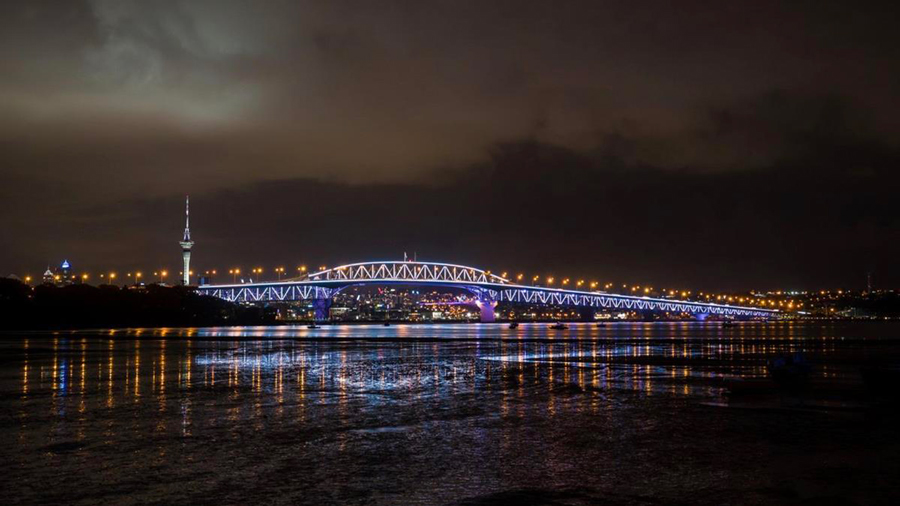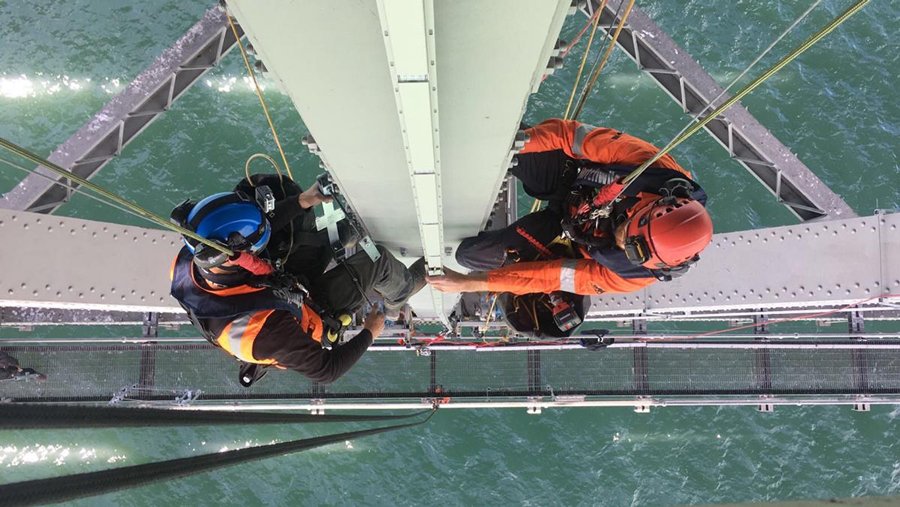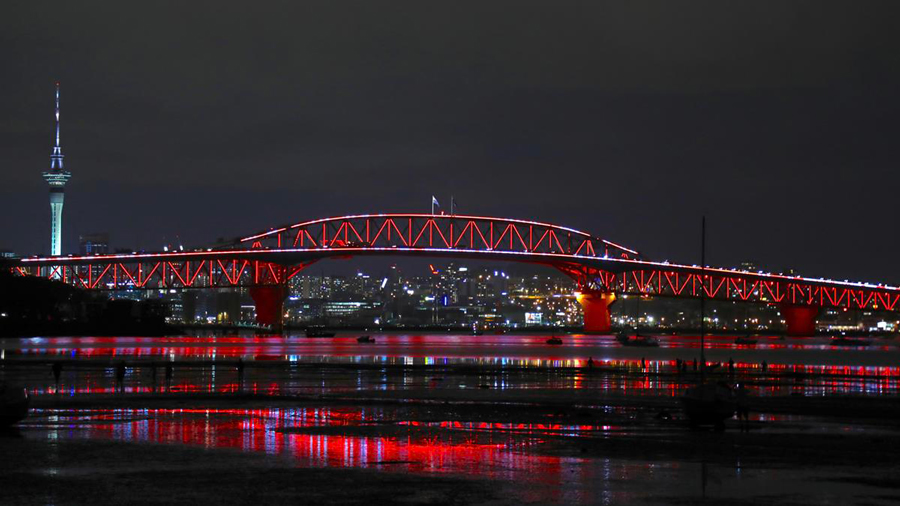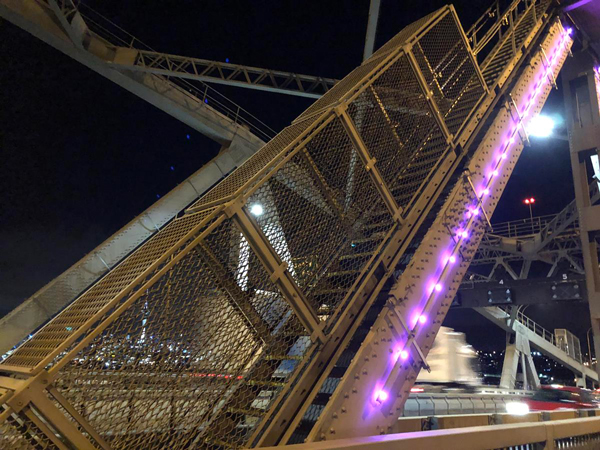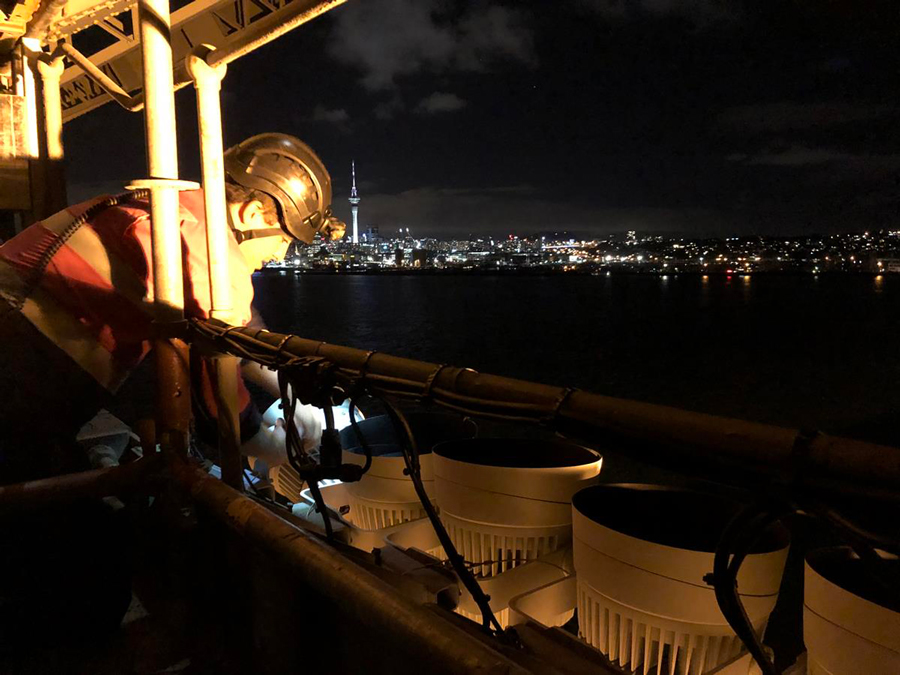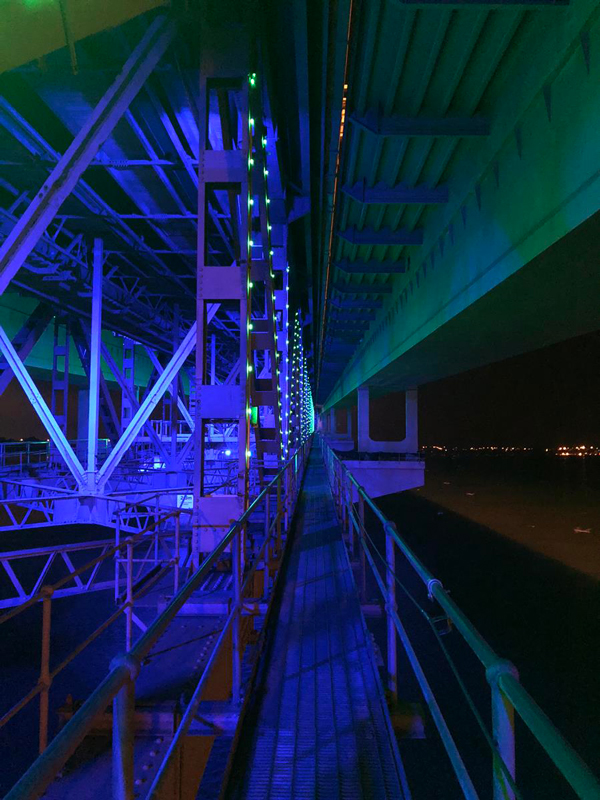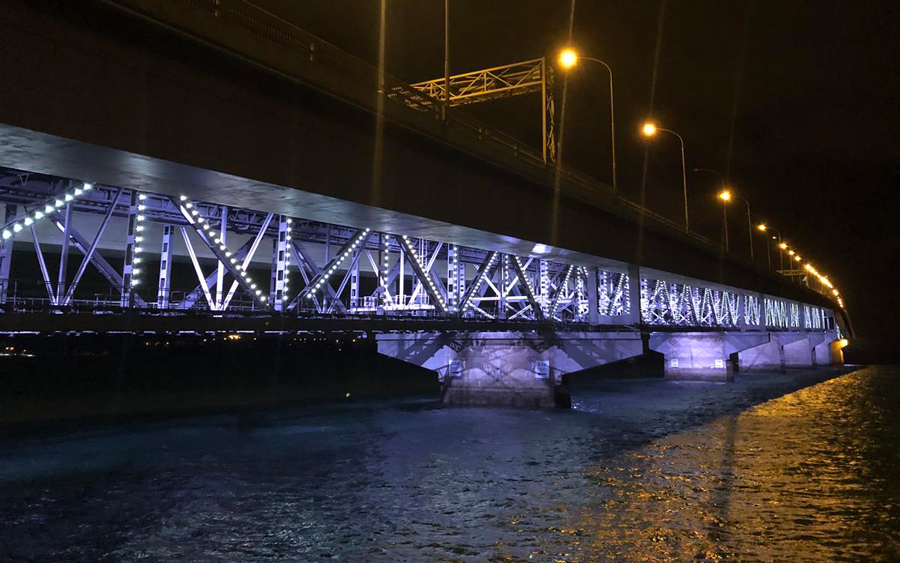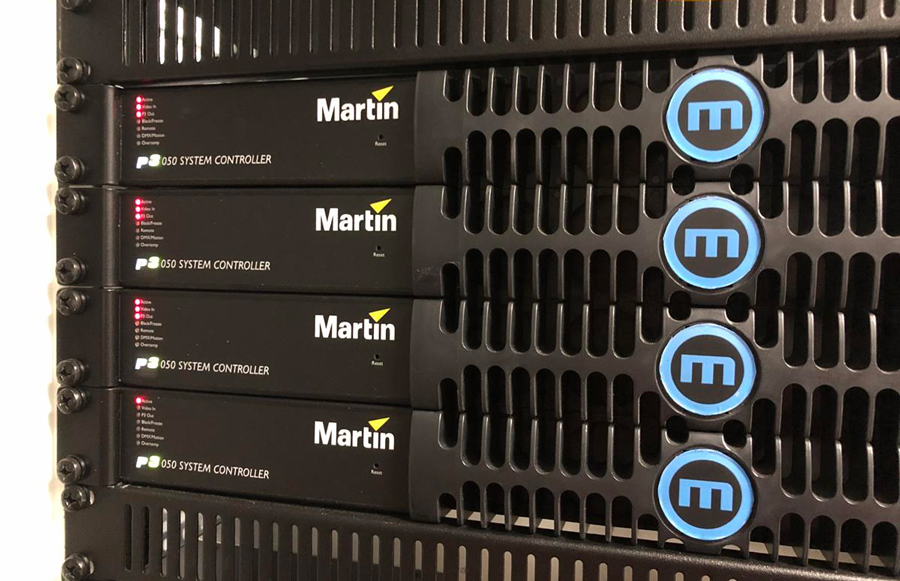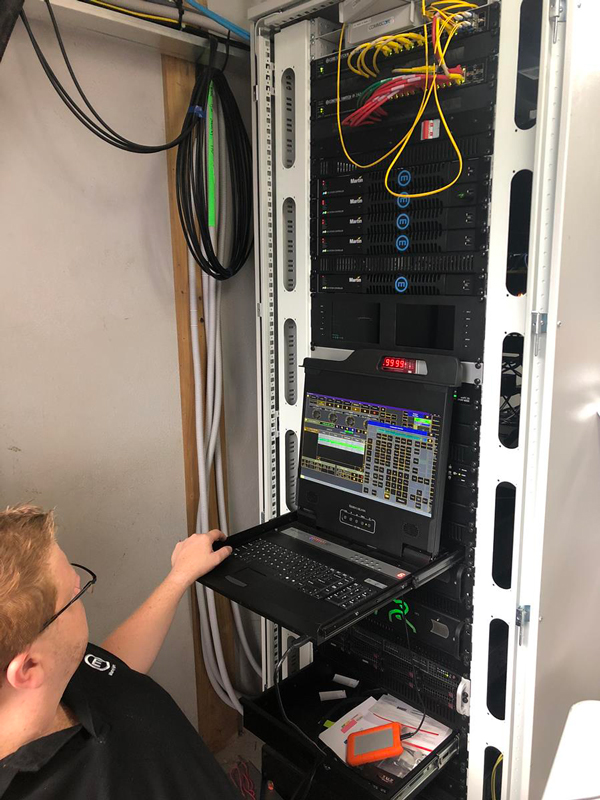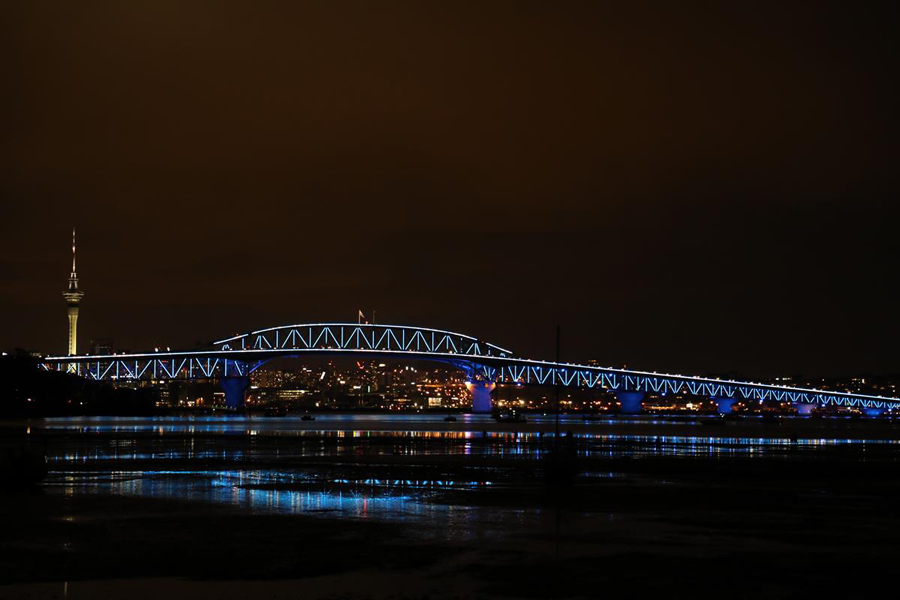On Auckland Anniversary Weekend, Saturday 27 January 2018, Auckland Harbour Bridge was transformed by the launch of Vector Lights – featuring a ground-breaking renewable energy technology powered light show that ignited imaginations and demonstrated a smarter way to power our city.
The installation is designed, managed, installed and programmed by internationally-acclaimed Mandylights, demonstrating the new lighting capabilities and a smarter way to power Auckland as part of a ten-year smart energy partnership between Vector Limited and Auckland Council.
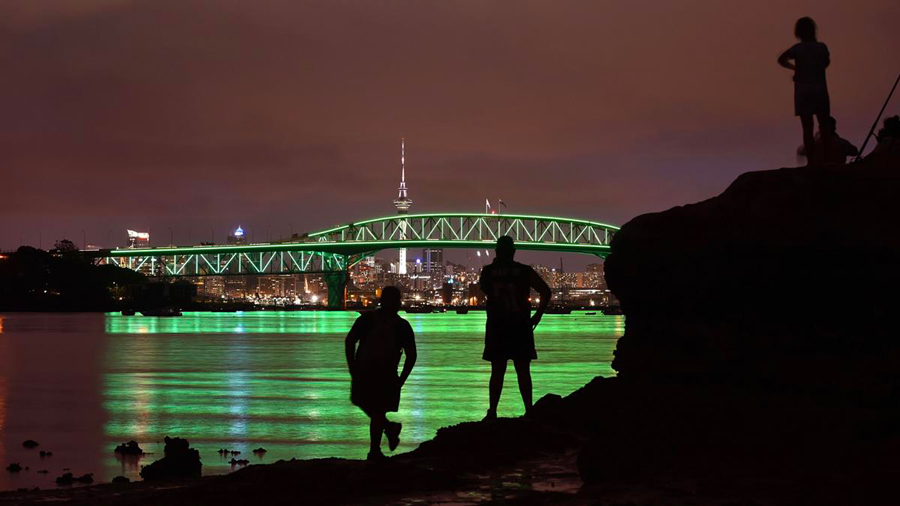
The audio-visual performance is made up of three chapters – the first references Tama-Nui te Ra (the sun), the original source of energy, and the second Hikohiko (electrical energy) representing it as energy and technology, and the final Hei te Ao Marama (the future world of light) as an acknowledgement to the diversity and culture in Auckland. The tender for this long term project was won by Sydney-based design and production company, Mandylights.
“We approached this architectural project in the same way as we approach any light artwork, concert tour or special event design” said Richard Neville, Managing Director of Mandylights. “Put simply, we want to make it look cool. Our design, pitch and attitude has always been to eschew the traditional mathematical, paint-by-numbers architectural lighting design approach in favour of coming up with a highly spectacular design that turned the bridge into its own unique light show.”
“We needed to be able to show how we would communicate Maori designs and traditional patterns through whatever we did on the bridge,” added Richard. “Another important creative element was to emphasize the connection to the water. The bridge sits very low down to the harbour which is unusual. Of course, it had to be cost effective too.”
Mandylights spent a lot of time looking at the physical architecture of the bridge. One of the first things Richard did was to fly to Auckland to spend a night sitting in various locations around the city simply taking in all aspects of the structure. He imagined ways to accentuate what is already there, especially the unique structure of girders that sit under the road. Vector were looking for a way to illuminate the Harbour Bridge in a highly energy efficient manner. The design had to be sympathetic and able to communicate New Zealand ideals and values.
“There’s a fascinating level of detail in all the girders beneath the road deck so we were quite keen to light that up,” he said. “We had to consider that people can get very close to the bridge and can see into all the gantries just sitting beneath the road deck, so that meant multiple views. Close up and personal, or from Waiheke Island 30 kilometres away, you can still see the lighting. It was a big challenge to come up with something that had multiple levels of engagement and offered viewers a unique experience at different sites.”
Environment was probably the biggest challenge for Mandylights, located in the middle of the harbour with the crew getting blasted by winds in excess of 70 Km an hour. Add to that salt spray and in some locations the fixtures are only six metres away from the water.
“There was constant hammering from water and wind plus Auckland has temperatures well into the 30 degree Celsius range so you need UV protection,” commented Richard. “Also, the installation has to last for ten years so exposed cables was a massive consideration as well. On top of that, the Bridge is constantly moving with the vibrations from traffic.” The outside lanes of the bridge were added after the main structure was built in 1959, with the four clip-on lanes added in 1969. In a matter of seconds, this road deck can move by up to a metre as the load on the road decks above change.
Other technical challenges were access and many of the places where lights were installed were incredibly difficult to get to. Rise Pacific, a specialist rigging company from Sydney, designed and built a completely unique access system to get the Mandylights crew specifically to where they needed to go.
From the beginning Richard was clear that he wanted to light the Bridge with three types of LED fixtures in three very definite styles. A wash light was required to light the internal structure of the Bridge, a linear strip to outline the entire exterior perimeter of the structure and finally, an LED dot fixture for the 170 diagonals and verticals under the Bridge.
“We wanted to highlight the internal structure of the Bridge by lighting the girders and also pointing some lights down to reflect off the water,” explained Richard. “We wanted the most amount of colour and reflection we could off the water to emphasis the connection with the water.
With the linear strips we wanted to outline the road deck and the arch as I don’t think people realise what an arced, sweeping shape it has. Finally, we used LED dots to turn the outer girders of the bridge into what is effectively a low res video surface, made out of the bridge architecture itself.”
Mandylights looked at a few variations of applicable LED fixtures but found they gravitated towards Martin by HARMAN due to the reliability of product and the incredible support offered by HARMAN Professional Solutions country partner, Show Technology.
“We worked extremely closely with Martin on this project as there were many custom components needed, including a 505mm pitch on the VC dots to allow for thermal expansion in the hot months,” commented Michael. “Alterations were needed for the steel to expand and contract without ripping the ribbon tails out of the fixtures on a hot day. A similar customization was needed for the 1,990mm Exterior PixLines to lower fixture count and make them a practical size for the treacherous install; also considering thermal expansion of course.
Martin were really supportive and fantastic to deal with on such a massive undertaking, it was their largest LED installation to date with over 90,000 LEDs installed. Simply put, there wasn’t much that was off the shelf and they helped to tailor their reliable products to meet our specific needs.”
“The fact that Show Technology has an Auckland office and were able to support the project locally, was very important to us,” explained Richard. “We had a very tight window for pitching this project and to present the initial creative response, and the fact that we were able to turn up to the first pitch meeting with actual working samples of the products was really beneficial.”
Show Technology worked alongside Mandylights throughout the entire installation period allowing them to warehouse and prep the fixtures in New Zealand and offer ongoing technical consults throughout the project. The installation process took just over five months and Richard commented that there were a lot of Work Health and Safety restrictions to overcome.
Due to high winds on the bridge there were even a few weeks when the crew were unable to work because some of the necessary equipment for the installation on the Bridge would not be safe over certain wind speeds. During the lighting installation, the whole Bridge power system was being reconfigured to run the Bridge off the solar and battery grid.
MARTIN EXTERIOR WASH 200
Martin Exterior Wash 200 were chosen for wash lighting with Richard describing them as bright and versatile. The Exterior Wash 200 is a compact and energy-efficient LED lighting fixture designed to illuminate mid-sized structures and building facades.
A discreet, optional snoot integrates seamlessly with the slick design of the fixtures. It has built-in display for ease-of-use, a wide selection of beam angles and is fully IP-rated for permanent outdoor use.
The Exterior Wash 200 is designed for narrow beam applications and is based on separate LEDs for red, green, blue and white. “We tested these several times in our office and then again on site, and we found them to be simply perfect,” said Richard. “They have really good colour range – especially in the deep blue ranges and importantly, a really easily interchangeable system of frosting so we were able to use the same fixtures all the way across the Bridge.
In many places they’re throwing 10 or 20 metres with 60° diffusion on but then the same fixtures are throwing nearly 150 metres across the main navigation span to under-light the road deck.”
MARTIN PIXLINE 40
Martin’s Exterior PixLine 40 is a linear LED video fixture for media facades and creative installations. The Exterior PixLine can be combined with a wide variety of lenses and diffusers for the right look for every application. The fixtures can be fully customized in terms of length and colour to match every installation requirement, while the power source is hidden.
“Martin were very accommodating creating a custom length PixLine for us which is longer than their usual fixtures,” said Richard. “We designed a custom mounting system to clamp them to the Bridge, so the whole installation sits very smartly with the profile of the road deck.”
Discussing the fixtures’ installation, Richard described the process of installation as being remarkably smooth and with Mandylights’ Technical Designer Clint Dulieu mastering the system’s P3 controllers, they had the fixtures running their content within hours of them being hung.
MARTIN VC-DOT 9
Mandylights also worked closely with Martin customizing the mounting system for the VC-Dot 9 whilst at the same time designing a series of brackets to hold the VC-Dots to the Bridge. VC-Dot 9 is a lightweight string of individually controllable, bright Dots useful in creating customized LED video solutions with maximum artistic flexibility. Mapping video onto VC-Dots is intuitive via the P3 System Controller. VC-Dot 9 contains nine LEDs and is available in an RGB colour mixing version.
“For this project, the VC-Dot 9’s have custom spacing and there are over 10,000 on the Bridge,” Richard elaborated. “The VC-Dots are cool creatively as when you’re really close up to the Bridge you can see these dots that are installed at 500mm spacing and the Bridge looks like it’s covered in thousands of coloured dotted lights. Then as you move back to say one kilometer away, your eye doesn’t see the distance between the dots and the dots appear as solid lines. They deliver two different viewing experiences.”
CONTROL
A total of 90,000 Martin VC-Dots were used on the Bridge marking Martin’s largest ever architectural LED installation. All of the Martin equipment runs off the Martin P3 System Controller which is fed video by two media servers.
However the entire system is controlled by an MA2 network so at every distribution board installed on the Bridge by Mandylights, there’s an MA2 4Port Node. Additional Nodes are in the control room.
“We wanted to put an industry standard control system in place so if we decided to do something different, such as add searchlights for NYE, we have distributed DMX points all across the Bridge that are ready to go,” added Richard.
“Similarly, if we need to integrate the Bridge with other projects in the city it can all jump on one huge citywide network and essentially there’s no reason why a waterfront concert can’t integrate the Bridge too.”
The Bridge lighting can be remotely managed by Mandylights who will design custom content for special events such as the upcoming Chinese New Year and also Waitangi Day.
“Clint Dulieu worked very closely with Vector to get the whole system online so it can be remotely managed,” explained Richard. “We can conduct maintenance, get feedback on any malfunctions, upload new content and reprogram the Bridge from our Sydney office or basically anywhere in the world that we might be working.” In between the special events, the lighting is used to subtly frame the architecture of the Harbour Bridge each night.
POWER
The Bridge is the first main bridge in the world to have all its lighting needs fully met by solar and battery technology. The project integrates a mix of leading technology, using the latest solar, battery and peer-to-peer systems to deliver stored energy to the bridge.
By using peer-to-peer technology, it is possible to virtualise the connection between the battery and the bridge and therefore balance the energy being used and discharged at any time.
Energy generated by the solar panels, situated in Wynyard Quarter, is stored in Tesla Powerpack (a battery). Currently there are 248 solar panels providing energy for the bridge with more to follow bringing the total to 600.
Smart meters situated at the battery installation and on the bridge will relay data between each other every 10 seconds. This means that the amount of energy Vector Lights uses at any one time will be relayed back to the battery which will then release this amount of energy back into the grid – ensuring a constant balance.
By using solar and battery to power Vector Lights, as opposed to traditional means, 13.6 tons of carbon is prevented from going into the atmosphere each year. When the additional solar panels are installed and battery to power the street lights on the bridge, the carbon avoided each year will increase to 27 tons. Vector Lights is part of a wider 10-year smart energy partnership between Vector and Auckland Council, with the Vector Lights project being delivered in collaboration with the NZ Transport Agency.
“It is a privilege to see Martin products be part of New Zealand’s iconic Auckland Harbour Bridge,” said Ramesh Jayaraman, VP & GM, HARMAN Professional Solutions, APAC. “Besides Martin’s product reliability, we acknowledge that having a local partner with great expertise and support, is key to every project. We are thankful to our partner – Show Technology, for their expertise, innovativeness, commitment to every project and customer first approach.”



